Construction plans leave the fate of Greenland’s main airport up in the air
Greenlandic lawmakers are ready to build new airports. They are less prepared to make a decision about what to do with one of the facilities they will replace.

For most people who fly to Greenland, the first place they set their feet on the ground is the tarmac at the airport in Kangerlussuaq. Only the fewest of the 300,000 people who land in Kangerlussuaq each year end their travels there, however. Those involved in commercial activities or public affairs typically fly onward to Nuuk, the capital. Pleasure travellers are most likely to end in Ilulissat.
Together, the two cities are the destinations for a third of people travelling to Greenland. Because of their popularity, lawmakers in Nuuk would like to upgrade to the airports that serve them, making it possible for them to receive intercontinental jets and thus eliminating the need to transfer in Kangerlussuaq.
A third airport is likely to be built in Qaqartoq, Greenland’s fourth-largest town, in the extreme south. Currently, anyone wishing to travel there must fly by helicopter from the airport at Narsarsuaq, located some 40 miles (60 kilometers) to the northeast. If the airport in Qaqortoq is built, the setup would, in all probability, be reversed.
[As Greenland’s plans to build new airports gather momentum, Denmark is struggling to get on board]
Kangerlussuaq’s fate is less certain. Nuuk has put forward two options for what do with it once the new airports are up and running: Downgrade the facility to a heliport, or keep it as an airport but cut the length of its runway in half, to 5,000 feet (1,500 meters).
While neither is especially attractive for lawmakers in Nuuk, both, according to a report compiled by Deloitte and paid for by Self-Rule administration, are better than the current situation. If nothing is done, Nuuk will need to invest 1.1 billion kroner ($170 million) over the next 25 years to repair and then maintain the runway, damaged by thawing permafrost, and to renovate buildings and other infrastructure. This will also mean that travellers will still need to transfer in order to reach their destination.
Keeping Kangerlussuaq open, but with a shorter runway, according to Deloitte, would have similar costs, but they would, for the most part, be offset by the gains realized from opening the airports in Nuuk and Ilulissat.
[As tourism to Greenland grows, the country looks to grow tourism infrastructure to match]
Only a decision to convert Kangerlussuaq to a heliport would end up saving the country money in the long-run. The calculation leaves out certain hard-to-estimate factors, though, including the potential economic development a full-fledged airport could generate. Such benefits might make it easier for lawmakers to keep avoid having to close the runway entirely, despite the costs associated with keeping it open.
Part of Kangerlussuaq’s attractiveness is that it offers easy road access to the icecap, making it a frequent departure point for scientific expeditions. Likewise, its location at the end of a fjord means it is an ideal place for cruise-ship passengers to embark on their journey, to the point that, in 2017, national lawmakers announced that Kangerlussuaq was one of three ports that would share 60 million kroner for port infrastructure improvements. Moreover, in recent years, automakers have set up cold weather test facilities there. Taking away easy access by air jeopardize all of these activities.
Independent economists have cast doubt on the report’s conclusion that new airport construction is the best option. They argue that, given size of the investment (at 4 billion kroner, it is the country’s largest project ever) and the significant uncertainty tied to rerouting the country’s air traffic (relying on Nuuk, in particular is a concern, given its notoriously poor weather), it would be safest, and perhaps most beneficial in the long run, to renovate existing airports and invest the leftover money elsewhere.
[Denmark, Greenland agree to revisit airport funding, putting Chinese investment on hold]
Another consideration is Denmark’s obligation to the United States to keep Kangerlussuaq operational. Built in 1941 by the U.S. military, Kangerlussuaq was transferred, lock, stock and barrel, to the Danish state in 1992 for the sum of $1 — but on the condition that American forces could commandeer the airport and close its airspace to civilian traffic, should military operations require it.
Currently, this seems like a far-off possibility. Only a handful of U.S. military planes land there each year, most of them in connection with supply missions for scientists working on the icecap. Nevertheless, the agreement is one that Mittarfeqarfiit, the national airport authority, appears see commercial potential in: In May it agreed to the terms of a five-year deal to provide lodging to U.S. service members on duty in Kangerlussuaq, as well as flight services for their aircraft.
So a decision on Kangerlussuaq’s future appears to be delayed.